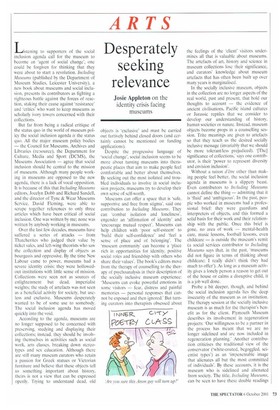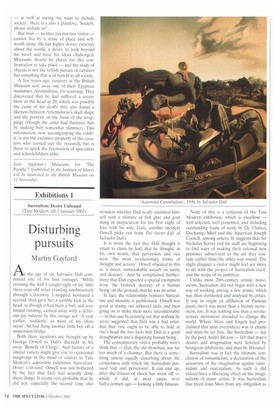Desperately seeking relevance
Josie Appleton on the identity crisis facing museums
Listening to supporters of the social inclusion agenda call for the museum to become an 'agent of social change', one could be forgiven for thinking that they were about to start a revolution. Including Museums (published by the Department of Museum Studies, Leicester University), a new book about museums and social inclusion, presents its contributors as fighting a righteous battle against the forces of reaction, staking their cause against 'resistance' and 'critics' who want to keep museums as scholarly ivory towers concerned with their collections.
But far from being a radical critique of the status quo in the world of museum policy the social inclusion agenda is the status quo. All the major museum policy bodies — the Council for Museums. Archives and Libraries (re:source), the Department for Culture, Media and Sport (DCMS), the Museums Association — agree that social inclusion should be central to the mission of museums. Although many people working in museums are opposed to the new agenda, there is a lack of vocal opposition. It is because of this that Including Museums editors, Jocelyn Dobb and Richard Sandell, and the director of Tyne & Wear Museums Service, David Fleming, were able to scrape together references to only three articles which have been critical of social inclusion. One was written by me; none was written by anybody working in museums.
Over the last few decades, museums have suffered a series of attacks — from Thatcherites who judged their value by ticket sales, and left-wing theorists who saw the collection and display of objects as bourgeois and oppressive. By the time New Labour came to power, museums had a severe identity crisis; they were hollowedout institutions with little sense of mission. Collections were seen not as sources of enlightenment but dead, imperialist weights; the study of artefacts was not seen as a beneficial activity for society, but useless and exclusive. Museums desperately wanted to be of some use to somebody. The social inclusion agenda has moved quickly into the void.
According to the agenda, museums are no longer supposed to be concerned with preserving, studying and displaying their collections; instead, they should be involving themselves in activities such as social work, arts classes, breaking down stereotypes and sex education. Although there are still many museum curators who retain a passion for Greek statues or Victorian furniture and believe that these objects tell us something important about history, theirs is not a view that can be expressed openly. Trying to understand dead, old objects is 'exclusive' and must be carried Out furtively behind closed doors (and certainly cannot be mentioned on funding applications).
Despite the progressive language of 'social change', social inclusion seems to be more about turning museums into therapeutic places that aim to make people feel comfortable and better about themselves. By seeking out the most isolated and troubled individuals to involve in social inclusion projects, museums try to develop their own sense of self-worth.
Museums can offer a space that is 'safe, supportive and free from stigma', said one contribution to Including Museums. They can 'combat isolation and loneliness', engender an 'affirmation of identity' and 'encourage mutual respect'. Museums can help children with 'poor self-esteem' to 'build their self-confidence' and 'feel a sense of place and of belonging'. The 'museum community' can become a 'place rich in opportunities for identity, positive social roles and friendship with others who share their values'. The book's editors move from the therapy of counselling to the therapy of psychoanalysis in their description of the socially inclusive museum experience: 'Museums can evoke powerful emotions in some visitors — fear, distress and painful memories — personal responses that cannot be exposed and then ignored.' But turning curators into therapists obsessed about the feelings of the 'client' visitors undermines all that is valuable about museums. The artefacts of art, history and science in museum collections lose their significance, and curators' knowledge about museum artefacts that has often been built up over many years is marginalised.
In the socially inclusive museum, objects in the collection are no longer aspects of the real world, past and present, that hold our thoughts to account — the evidence of ancient civilisations, Pacific island cultures or Jurassic reptiles that we consider to develop our understanding of history, human societies or nature. Instead, museum objects become props in a counselling session. Trite meanings are given to artefacts so that they teach us the desired socially inclusive message (invariably that we should be more tolerant/less prejudiced). '[The] significance of collections,' says one contributor, is their 'power to represent diversity and envision inclusion'.
Without a raison d'être other than making people feel better, the social inclusion agenda in museums is a slippery beast. Even contributors to Including Museums cannot define the thing — admitting that it is 'fluid' and 'ambiguous'. In the past, people who worked in museums had a professional brief: they were guardians and interpreters of objects, and this formed a solid basis for their work and their relationship with the public. Once this brief is gone, no area of work — mental-health care, music lessons, football lessons, even childcare — is outside the museum's remit (a social services contributor to Including Museums says that, in the past, 'museums did not figure in terms of thinking about childcare: I really didn't think they had much to offer'). As long as a museum activity gives a lonely person a reason to get out of the house or calms a disruptive child, it is a job well done.
Probe a bit deeper, though, and behind the social inclusion agenda lies the deep insecurity of the museum as an institution. The therapy session at the socially inclusive museum is as much for the therapist's benefit as for the client. Plymouth Museum describes its involvement in regeneration projects; 'Our willingness to be a partner in the process has meant that we are no longer sidelined and are now included in regeneration planning.' Another contribution criticises the traditional view of the conservator ('white-coated, begoggled, scientist types') as an `impenetrable image that alienates all but the most committed of individuals'. By these accounts, it is the museum who is sidelined and alienated from society. The title, Including Museums, can be seen to have these double readings — as well as saying 'we want to include society', there is a also a plaintive, 'Society, please include us!'.
But man — neither curator nor visitor — cannot live by a sense of place and selfworth alone. He has higher drives: curiosity about the world, a desire to look beyond his navel and have his ideas challenged. Museums should be places for this confrontation to take place — and the study of objects is not the selfish pursuit of curators but something that is of benefit to all society.
A few years ago, curators at the British Museum sent away one of their Egyptian mummies. Artemidorus, for scanning. They discovered that he had suffered a severe blow to the head at 20, which was possibly the cause of his death; they also found a likeness between Artemidorus's skull shape and the portrait on the front of the wrappings (though the artist had flattered him by making him somewhat slimmer). This information, now accompanying the exhibit, is not the exclusive property of the curators who carried out the research, but is there to spark the fascination of specialists and schoolchildren alike.
Josie Appleton 's Museums for The People'? (published by the Institute of Ideas) will be launched at the British Museum on 11 November.



































































































 Previous page
Previous page